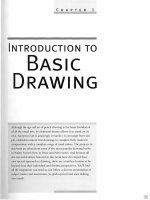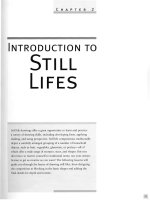Master the art of photographic composition how to create truly artistic photographs in 30 simple steps by anne darling
Bạn đang xem bản rút gọn của tài liệu. Xem và tải ngay bản đầy đủ của tài liệu tại đây (4.44 MB, 117 trang )
MASTERTHEARTOF
PHOTOGRAPHICCOMPOSITION
ByAnneDarling
KINDLEEDITION
©Copyright2014byAnneDarling
Thankyoufordownloadingthisbook.Allimagesandtextarecopyrightedbytheauthor
andmaynotbereproduced,copiedordistributedforcommercialpurposes.Ifyoufindthis
book helpful, please consider reviewing it on Amazon.com and recommend it to your
friends.Thankyouforyoursupport.
Followmyphotographyblogat
CoverImage:SampanBoatman,Shaoxing,China
DEARREADER
Photographyhasnotchangedsinceitsoriginexceptinitstechnicalaspects,whichforme
arenotimportant.(HenriCartier-Bresson,1908-2004-Frenchphotographerconsideredtobethefatherof
photojournalism)
I have been a photographer for several decades now, and remember as a child the
photographsmyfathertookwithhisBoxBrownie.Overtheyears,Ihaveprogressedfrom
simpleroll-filmcameras,to35mmSLRcamerasandmediumformat,andfinallydigital.
Technologyhaschangedthewayphotographersworkbutthevisiontheyseektoexpress
is still governed by the same rules of composition that visual artists have used for
centuries.Theserulescanbelearnedandoncelearned,forgotten,oratleastrelegatedto
thesubconsciousmindwheretheywillcontinuetoinfuseandinform.
This concise book is designed to take you through 30 steps to mastering the most
importantoftheserules.Readandstudytheimagesandpracticetheexercisesthoroughly,
andyouwillgainthatmastery.
Iwishyougreatsuccesswithyourphotography.
AnneDarling,BSc(1st.Hons),MAInternationalPhotojournalism
Chantillac,France,2014
TABLEOFCONTENTS
INTRODUCTION
WHOTHISBOOKISFOR&HOWTOGETTHEMOSTOUTOFIT
WHATISCOMPOSITION?
PARTI:FRAMING
1.MOVINGIN
2.ZOOMINGIN
3.MOVINGAWAY
4.FRAMINGPART1
5.FRAMINGPART2
6.FORMAT
PARTII:LINE&SHAPE
7.STRAIGHTLINES
8.CURVEDLINES
9.LEADINGLINES
10.RECTANGLES
11.CIRCLES
12.TRIANGLES
PARTIII:MOVEMENT
13.PATTERN&RHYTHM
14.FREEZINGTHEACTION
15.MOTIONBLUR
PARTIV:PICTUREDEPTH
16.PICTUREDEPTHPART1
17.PICTUREDEPTHPART2
18.PICTUREDEPTHPART3
PARTV:RELATIONSHIPS
19.POSITIVE&NEGATIVESPACE
20.RELATIONSHIPSBETWEENOBJECTS
21.RELATIONSHIPSINSIZE
22.RELATIONSHIPTOTHEENVIRONMENT
PARTVI:AVAILABLELIGHT
23.SILHOUETTES
24.AVAILABLELIGHTPART1-MAKINGLIGHTTHESUBJECT
25.AVAILABLELIGHTPART2-INDOORPORTRAITS
26.AVAILABLELIGHTPART3-SHOOTINGATNIGHT
PARTVII:LANGUAGE
27.STORYTELLING
28.METAPHOR
29.BREAKINGTHERULES
30.IMAGINATION
INTRODUCTION
Theworldweliveinisa3-dimensionalworld.Tocomplicatethingsfurther,itcontains
elements which are in constant motion. This makes things difficult if you are a
photographerbecausetheaimistocreatesomethingthatis2-dimensionalandstatic.
So for an image to look real and to communicate effectively with your viewers, it must
possessanorganisationofelementsthatconvincesthemofits3-dimensionalreality,and
thatismeaningfulatthesametime.
To organise the pictorial space we use the rules of composition. They give to an image
what grammar gives to prose. Compositional rules add structure and organise ideas in a
way that the viewer can understand. By understanding how composition works, the
photographer has the power to communicate his/her ideas clearly and powerfully. These
rulesarethemeanswherebythephotographercanarticulatehisorherpersonalvision.
Ifyouwanttolearntoplaythepiano,youhavetopractisescalesandchordsuntiltheyare
second nature. Only then can you begin to express yourself fully. Likewise with
photography,itisimportanttopractisetheelementsofcompositioninisolationuntilthey
toobecomesecondnature.
Likemusic,wherethescalesarenotheardinthefinalpiece,compositionalelementsare
theretohelpyoubuildastructurethatispresentsubconsciouslyandwhichyoubuildyour
image on. If you learn the rules thoroughly they will become an in-built and automatic
partofyourvisuallanguage.
WHOTHISBOOKISFOR&HOWTOGETTHEMOST
OUTOFIT
Thisbookisforanyonewhowantstobemorecreativewiththeircamera,whowouldlike
tomakephotosthataremore‘artistic’andwhoisnotafraidtogetoutofAutoModeand
startchoosingthecamerasettingsbasedontheknowledgetheywilllearnfromthisbook.
Togetthemostoutofthisbookyouwillneedacamerawhichletsyousettheaperture
(AV), shutter speed (TV) and ISO manually. You only need a superficial knowledge of
thesesettingsoratleastbewillingtoreadthecameramanualtofindouthowtheywork.
Don’tworrytoomuchifthesetermsareabitvagueatthemoment.Throughreadingand
studying the examples in this book, and working on the exercises, you will gain an indepthunderstandingofthecontrolsonyourcamera.
Myaimistogiveyoutheknowledgeandthepractice,in30photographicexercises,tobe
able to make these choices intuitively so that you can really capture an image as you
originallyimaginedit-perhapsevenbetter!
Trytoputintopracticetheexerciseattheendofeachsectionbeforegoingontothenext
one.Youdon’thavetoreadthebooksequentiallybutitisthebestwaytogetthemostout
ofitasthesectionsaredesignedtograduallybuildintoabodyofknowledge.Ifitisnot
possible to do the exercises sequentially, please be sure to go back and practice any
exerciseyouhadtoskip.
Takeasmuchoraslittletimeoneachexerciseasyoucanmanage.Iwouldsuggestthat
youonlydooneexerciseonanyonedaytogiveyoutimetofullyabsorbeachideabefore
moving on to the next. The 30 exercises could therefore be completed in one month or
takeawholeyear.Itdependsonyouandyourothertimecommitments.Sopleasegoat
yourownpaceandmostimportantly,havealotoffun!
WHATISCOMPOSITION?
Compositionmustbeoneofourconstantpreoccupations,butatthemomentofshootingit
canstemonlyfromourintuition,forweareouttocapturethefugitivemoment,andallthe
interrelationshipsinvolvedareonthemove.-HenriCartier-Bresson
Forapictorialcompositiontowork,tobepowerful,toaffecttheemotions,itmusthavean
underlying harmony. Without harmony, there is no art - no music, no picture, no poem.
Harmony is the structure which holds our attention, which makes meaning possible and
whichallowsustocommunicate.
When we sense harmony as an underlying element in a picture it conveys a feeling of
wholenessorperfection.Withoutharmonyasanunderlyingprinciple,ourexperienceof
beautywouldnothappen.Harmonyinartisthereasonwhysomeworksofartendurefor
centuries,beyondfashionandstyle.
Composition is a set of rules which allows us, as artists and communicators, to create
harmony within a framework and to say what we want to say. The rules, once learned,
becomesubconsciousandinfuseandinformourworksothatwenolongerneedtothink
aboutthemconsciously.Thisbookhasbeenwrittentohelpyoulearnthoserules.
The book is divided into 30 double-page sections. I have included camera data where I
thinkitwillbeusefultoyou.However,noteveryimagehasdataincludedsincethisbook
is not meant to be a technical manual but a guide to developing your ability to see in
photographicterms.
Eachofthe30sectionsisself-containedbuttheydofollowon,onefromanother,soone
waytousethisbookwouldbetotakeawholeday’sshootforeachsection.Inthisway,
youcouldcompletealltheexercisesinonemonthormoreslowly,sayover15weekends.
Takeyourtimewitheachsection,makelotsofshotsforeachideaandreallyembedthe
conceptsinyourmind.Onceyouhavecompletedalltheexercisesyouwillhaveastrong
grasp of composition and will find yourself making shots you never dreamt of, using a
wholerangeofnewskills.
PARTI:FRAMING
Maybethecorrectlanguagewouldbehowthefactofputtingfouredgesarounda
collectionofinformationorfactstransformsit.-GarryWinogrand
1.MOVINGIN
The first technique is really very simple and as such it is often overlooked by many
photographers.Movinginmuchclosertoyoursubjectsothatitfillsthewholepicturearea
canmakeabigdifferencetothecomposition.
The image below was shot in a botanical garden in France and is a magnificent flower
called Magnolia Grandiflora. To make the shot, I had a friend help me by holding the
branch steady while I placed the camera lens right inside the petals. This was about as
closeinasIcouldgetandithasworked,theflowerfillstheframealmostentirely,creating
aninterestingcompositionwiththeanglesofthesoftwhitepetals.Thepetalsactedasa
diffusersothatthelightinsidewasstillbrightbuttheshadowsweresoft.
ThesecondimagewasalsomadeinFrance.AsIwasdrivingalongIspottedthisloveable
donkeystandinginafieldandquicklyparkedupinordertomakehisportrait.Donkeys
arecuriousanimalsandthisonemovedupclosetowhereIwasstanding.Iusedawideangle lens set to the shortest focal length of 10 mm (which is why the nose is
disproportionatelylarge)andfilledtheframealmostentirely.
Notethatwithanimalsandpeople,settingtheautofocustoasinglepointallowsyouto
choosewheretofocussoyoucanalwaysensurethattheeyesaresharp.
EXERCISE
Choose any subject that appeals - people, architecture, animals, and flowers - whatever
interestsyou.Useaprimelens(50mmoranylensthatisfixed)ifpossible.Ifyoudon’t
haveonethensetyourzoomlensto50mm(or35mmifyouhaveanSLRwithacrop
sensor)andstickwiththatsettingforallthephotosyoumakeforthewholephotosession.
Getinclosetoyoursubject,makeashot,thenmoveyourbodyinevencloser.Withoutthe
ability to zoom in and out you have to move your body much more and this way of
workingengagesyourmindandimaginationactively.
Make another shot where you get in so close that one single detail, such as an eye or a
flowerstamen,fillsmostoftheframe.Makeashotfromfurtherbackandthencompare
allthephotos-whichworksbest?Why?Keepshootingforthewholesession,constantly
movinginandoutfromyoursubjectandcomparingtheresults.Keepeverythinguntilyou
getbacktoyourcomputerandcomparethemallonabigscreen.Don’tdeleteanything‘in
thefield’.
2.ZOOMINGIN
Nowyougettostandstillanduseyourzoomlenstofilltheframe.Thisistheopposite
ideaofNumber1:MOVINGINbecausehereyouwon’tmoveyourbodymuchatallbut
willletthelensdoallthelegwork.
Thebeautifulwhitelilyinthefirstpicturewasnotshotcloseuptothecameralensbutit
does fill the frame completely as I used a zoom lens to make sure it did. I deliberately
choseafocallengthtoallowthepetalstovirtuallytouchtheedgesonthreesidesofthe
pictureframe.Therewasnoneedtocropafterwardsinaphotoeditorasthereisnothing
extraneousintheshot.Ididconsidercloningouttheantatthebottomoftheimagebuton
reflectionIlethimstay.
The sunflower and butterfly photograph also looks like it was shot close-up but it was
takenatafocallengthof300mm.Thesubjectheredoesn’tfilltheframecompletelybut
theareatotherightofthepetalsisanimportantelementofthecompositionandiscalled
negative space (more on that topic later). The important point is that there is nothing
superfluousinthisshot,sonoworkneedsdoneinthedigitaldarkroomafterwards.
Shutterspeed:1/640s
Aperture:f/6.3
FocalLength:300mm
ISO:200
EXERCISE
Useazoomlensandmakelotsofshotsofyourchosensubject.Beawareofthefoursides
oftheframeasmuchaspossible.Experimentwiththeamountofspaceyouleavearound
yoursubject.Trysomewheretheframeisfilledandtheedgesofyoursubjecttouchthe
edgesoftheframe.Thentrysomewherethereisjustthesubjectplussomenegativespace
asshownhere.Avoidthetemptationtothinkthatyouwillcropyourphotoswhenyouget
home in post processing by doing all the cropping in the field. This helps to train your
braintomakegooddecisionswhileshootingandnotrelyoncomputersoftware.
Findamovingsubjectsuchaschildrenplaying,aboatmovingonwateroradogrunning
andmakesomeshotswherethereisspaceinfrontofthemainsubject.Noticehowthis
givesspaceforthesubjecttomoveinto.
Compareyourimageswiththoseyoumadeinthefirstexercise.Bothmethodsofworking
arevalidbutit’simportantthatyouunderstandthedifferenceandcanmakeaninformed
choice,dependingonyoursubject.
3.MOVINGAWAY
Sometimesyoumayfindthatthephotographyouwanttotakeisofthespotwhereyouare
actually standing. You are positioned inside your own photograph! This may mean you
havetomovefurtherafield.ForthisshotIhadtomovefromthequarry,whereIstarted
out,walkrightaroundandupthehilltomakeashotlookingdownonthescene.Thiswas
agood5-10minutewalkbutmyeffortwasrewardedwithagreaterviewwhichincluded
thedeepgreenwater,thebirdsandthehugecrane.
Ithelpstovarytheheightandangleatwhichyoushoot.Asaphotographerthistendsto
make you engage more fully with the visual scene in front of you, and helps to create
moreinterestingpictures.Photographingchildreninparticularcanbevastlyimprovedby
bendingyourkneessothatyoucanmakeshotsthatdepicttheworldfromtheirviewpoint.
Shootinghigherupmayallowyoutoincludeadditionalinformationthatwouldbelostif
youwereoneyelevelwithyoursubject.ThiscanbeseeninthepictureoftheChinese
imamwhereIhaveshotfromhighuptoincludetheviewofpagesoftheQur’anwhichhe
has open in his hands. This is called an environmental portrait. Information is included
withintheframeinordertotelltheviewersomethingmoreaboutthelifeofthesubject.
Shutterspeed:1/25s
Aperture:f/6.3
FocalLength:18mm
ISO:800
Ihavealsoshotwiththecameraonthediagonal.Itcreatesaslightshockwhenyoufirst
seeapicturelikethisbecausewearesousedtohavingeverything‘squared’up.Shooting
onthediagonalalsohasthemeritoflettingyoufilltheframe.Noticethatagainthereis
noextraneousinformationintheshot,justastrong,simplecomposition.
EXERCISE
Children and animals are good subjects for practising shots low down. Try to include
flowersandotherobjectsthatwouldbeintheirfieldofvisionatthatheight.Thenmakea
seriesofshotsfromahigher-than-normalvantagepoint.
Go out in the world and try to find a place to stand that is filled with incident and then
lookaroundforaplaceashortdistancewaywhereyoumightlookbackandgetagood
view of your current position. Engage your imagination fully in this exercise before
decidingonthebestvantagepoint.
4.FRAMINGPART1
Framingisatechniqueoftenusedbyphotographerstoenhancethelookofarchitectural
images.Havingaframearoundyourcentralsubjectissaidtokeeptheeye,whichmoves
constantly,fromwanderingoutoftheframe.Simultaneously,framingaddstheillusionof
depthtothephotograph.Onewaytoframeabuildingistousetrees,branchesoranything
youcanfindnearby.
Inthetwopicturesinthissection,youcanseethewonderfuloldAbbeyatBassacnearmy
homeintheCharenteregionofFrance.Ihaveusedtheframingtechniquetoaddinterest
tobothshots.
ThefirstphotousesshrubsandbranchestotrappartoftheAbbeybuildinginanatural
frame.Theycreateaforegroundplanewhichgivesthefeelingthatwearepeepingthrough
thefoliageatthebuildingasifspyingonit.
Shutterspeed:1/160s
Aperture:f/5.6









